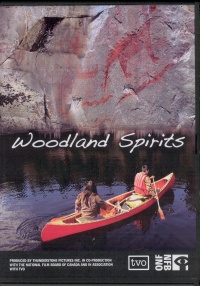| ________________
CM . . . . Volume XVI Number 25. . . .March 5, 2010. 
 |
Woodland Spirits.
Dave Clement (Writer & Director). Dave Clement, Anita Lee & Lea Marin (Producers).
Montreal, PQ: National Film Board of Canada, 2007.
28 min., DVD, $99.95.
Order Number: 153C 9107 291.
Subject Headings:
Woodland art-Ontario.
Art, Canadian-Ontario.
Indian art-Ontario.
Grades 11 and up / Ages 16 and up.
Review by Joanne Peters.
**½/4
|
| |
|

For many people, the bold colours, black outlined-figures, and stylized representations of animals –– the Woodland School –– is what they envision as “Aboriginal art.” While Norval Morrisseau is one of the most popularly-known Woodland artists, it is the late Roy Thomas, critically-acclaimed Woodland artist and founder of Thunder Bay’s Ahnisnabae Gallery, who has strongly influenced the work of the three painters featured in this NFB production. Gelineau Fisher, Moses Beaver, and Andrew Machendagoos are all inspired by the raw beauty of northwestern Ontario as well as by the teachings and traditions of their culture. The bold colour and strong outlines of Woodland paintings derive from the petroglyphs still visible on large rock outcropping which form the shorelines of so many northern Ontario lakes.
Thomas’ widow, Louise, continues to run the Gallery which features the work of Fisher, Beaver, and Machendagoos, as well as many other Aboriginal artists, and her commentary, as well as voice-over readings from Thomas’s biography, provide a sense of the history of the Woodland art movement, as well as its relationship to Aboriginal culture. Gelineau Fisher, the oldest of the three, continues to live a very basic existence in the bush country. It is an existence only slightly removed from that of past generations, and Fisher’s connection with the teachings of those ancestors is strong and powerful; he sees his art as the way to reach young Aboriginals and re-connect them with their heritage.
Moses Beaver is middle-aged; his life has been touched by a number of hardships and losses, including the death of his wife when he was only thirty-five. Art has been a means of expressing and working through his difficult life experiences, and he sees Roy Thomas as an important artistic mentor and Gelineau Fisher as an elder whose work is a crucial link in the spirit of Woodland art. Andrew Machendagoos is the youngest of the three men, a contemporary of Louise and Roy Thomas’s own sons, and he is just beginning to find his identity as an artist. Moses sees him as a younger version of himself and takes him on a trip to visit Gelineau’s “studio” in the bush, afterwards charging him with the task of painting the experience.
For those unfamiliar with the history and spirit of the Woodland artists, Woodland Spirits provides a brief introduction. However, in trying to incorporate artistic and cultural tradition, the role of the late Roy Thomas in fostering the work of Woodland artists, and the profiles of the artists, too much was attempted in just 28 minutes. Woodland Spirits can be a useful supplementary item for high school studies of Native art, but teachers should be prepared to provide additional content.
Recommended with reservations.
Joanne Peters is a teacher-librarian at Kelvin High School in Winnipeg, MB.

To comment on this title or this review, send mail to
cm@umanitoba.ca.
Copyright © the Manitoba Library Association. Reproduction for personal use is permitted only if this copyright notice is maintained. Any other reproduction is prohibited without permission.
NEXT REVIEW |
TABLE OF CONTENTS FOR THIS ISSUE- March 5, 2010.
AUTHORS |
TITLES |
MEDIA REVIEWS |
PROFILES |
BACK ISSUES |
SEARCH |
CMARCHIVE |
HOME |
